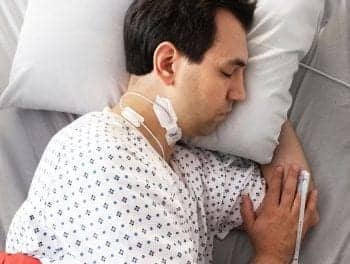The careful monitoring of patients with sepsis is key to management and care.
By Cassandra Perez
Over a million people each year are hospitalized as a result of sepsis, and nearly half of those cases result from infections in the lungs. With a mortality rate as great as 50% and frequent complications like acute respiratory distress syndrome (ARDS) or septic shock, proper care relies on accurate patient monitoring of cardiopulmonary vitals and blood oxygenation.
Sepsis: Statistics and Treatment
Sepsis, a clinical syndrome characterized by systemic inflammation, is a serious bloodstream infection that arises from various infections, such as those of the skin, lungs, and urinary tract.1 The National Center for Health Statistics of the Centers for Disease Control and Prevention (CDC) reports the number of times people were in the hospital with sepsis increased from 621,000 in the year 2000 to 1,141,000 in 2008.2 In addition, over 1,665,000 cases of sepsis occur each year in the United States, with a mortality rate up to 50%.3
For treatment of sepsis, major efforts to reduce sepsis-related mortality have focused on generating consensus definitions of sepsis and related conditions, as well as establishing guidelines for early identification and implementation of-goal directed therapy. Goal-directed therapy, which includes adjustments of preload, afterload, and contractility to balance oxygen delivery and oxygen demand, has been used to treat severe sepsis and septic shock patients.4 Additionally, studies have been undertaken to identify new sepsis biomarkers and therapies.
Clinical studies show that mortality is significantly reduced if septic patients are identified and treated at early stages of the disease process. They key elements in treating severe sepsis and septic shock includes early antibiotics, early recognition and intervention, source control, and hemodynamic support.4 According to the Medical Laboratory Observer, the recent revision and expansion of guidelines, with a deeper understanding of the pathophysiology of sepsis and availability of novel diagnostic and therapeutic tools, points to a better forecast for this disease in the future.5
Veffa Devers, RN, BSN, MS, CCRN-A, vice president of clinical excellent programs at Nihon Kohden, and Rich Swenson, senior product manager of patient monitoring at Nihon Kohden, stated, “Early recognition, response, and treatment to the likelihood of sepsis is a team sport in which every member of the care team plays a vital role.”
Health Risks
According to the CDC, sepsis is difficult to diagnose and treat, and patients who develop sepsis have an increased risk of complications and death and may also face lengthy treatment and higher healthcare costs.2 Early aggressive treatment increases the chances of survival, but despite high treatment expenditures, sepsis and septicemia are frequently fatal. Patients who survive severe sepsis are more likely to have permanent organ damage, physical disability, and cognitive impairment.1
The risk of sepsis-related mortality increases with age and coexisting diseases such as diabetes, and without appropriate treatment, sepsis can progress to severe sepsis and septic shock, which causes approximately eight million deaths annually.5
According to Christopher W. Seymour, MD, MSc, assistant professor in the department of critical care and emergency medicine at the University of Pittsburgh School of Medicine, the main tenets of treatment7 to prevent sepsis-related complications include early control of the infection source, antibiotics, fluid bolus (as required), and frequent clinical and laboratory assessments of severity.
Seymour explained that sepsis is infection plus acute organ dysfunction, and patients with this condition may suffer from a variety of clinical problems. “They may be subtle like increased confusion, but as severe as profound hypoxemia and ARDS. Each patient is different, as a result of host and pathogen factors, such that the course of sepsis can be difficult to predict,” he said.
Respiratory failure is also a significant sepsis-related risk and can be difficult to prevent. “Clinical monitoring for respiratory distress through serial clinical exams, arterial blood gases, and directed radiology exams may help identify the patient who is deteriorating,” Seymour said.
An additional significant health risk is ARDS. Devers and Swenson state, “Sepsis patients can also develop ARDS, at which time respiratory management of the ARDS patient is essential.”
Keith D. Lamb BS, RRT-ACCS, supervisor of adult critical care and coordinator for extracorporeal life support and critical care research at Unity Point Health in Iowa, confirmed that ARDS is a severe health risk in sepsis patients. “ARDS often accompanies sepsis. This severe respiratory failure makes it exceedingly difficult to avoid…hypoxemic hypoxia and to prevent ventilator-induced lung injury (VILI),” he said.
Severe sepsis and septic shock frequently require large quantities of crystalloid infusion to treat hypotension, and this extra circulating volume can contribute to respiratory failure. Another health risk is multi-organ failure, which can also be caused by the initial and secondary inflammatory cascade, according to Lamb. “Patients with multiple organ dysfunction have an exceedingly high mortality rate,” he said.
Types of Sepsis Monitoring
Careful monitoring is essential because patients with sepsis may develop noncardiogenic pulmonary edema.3 “Clinical monitoring with frequent reassessments is the most important [consideration] among septic patients,” said Seymour. Patient monitoring in severe sepsis is implemented during resuscitation and should not delay initiation of resuscitation; however, hemodynamic monitoring provides for appropriate goals for directed therapy and should completed as soon as is feasibly possible.6
Hemodynamic monitoring includes right atrial pressure monitoring at a minimum and may include pulmonary artery for septic shock.6 Measurements should be continuous in this type of monitoring. “Sepsis is a clinical emergency, and patients with this life-threatening condition require frequent reassessments by clinicians, continuous cardiac monitoring, and in specific cases, advanced hemodynamic monitoring,” Seymour explained.
Lamb added, “Hemodynamic monitoring is essential for optimizing volume support…and vasopressor and inotrope support. This is often done invasively with arterial line placement, which represents real time changes in systemic blood pressure. Indwelling arterial lines also make blood gas analysis more convenient to obtain.”
Metabolic monitoring, another form of sepsis monitoring, includes serial measurements of serum lactate, glucose, electrolytes, and ionized calcium every eight hours initially.6 The C-reactive protein is measured daily. Coagulation monitoring is also an option for sepsis patient monitoring, and it includes INR, a PTT, D-dimer, and fibrinogen every eight hours initially, according to LSU Health Shreveport. Fluid monitoring includes total protein (to estimate plasma oncotic pressure) and albumin at least daily.
With the severe risk of respiratory failure among patients with sepsis, signs of hypoxemic respiratory failure can be monitored with blood gas analysis, pulse oximetry, and calculating PaO2/FiO2 ratios and oxygen index calculations. “All of these can be used to trend organ failure and adjust therapies, interventions, and supportive measures accordingly,” Lamb said.
As ARDS is a common cause of sepsis and often accompanies this condition, preventing it can only be done by limiting the exposure to known risk factors, according to Lamb. These are generally known by respiratory therapists to be associated with invasive positive pressure ventilation. “Monitoring for tidal volumes, end inspiratory pressures and end inspiratory transpulmonary pressures should be done if possible. Monitoring these parameters can be accomplished by simply taking these measurements with the available mechanical ventilator software,” Lamb explained. “End inspiratory transpulmonary pressure can be measured via esophageal manometry.”
For successful monitoring of sepsis patients, Seymour suggested a central line or arterial line may provide additional monitoring of blood pressure and access for intravenous fluids/medications for those on vasopressors. In addition, focused cardiac ultrasound and assessments of volume responsiveness may be considered in some patients, and pulse contour analysis via the arterial line should be reserved for select patient populations only.
According to Lamb, “Most clinicians maintain that monitoring for markers of organ dysfunction, injurious ventilator settings, and appropriate end organ perfusion are still the hallmark of proper management of sepsis patients.” Lamb added that it is essential to monitor end-organ perfusion to ensure EGDT (early goal directed therapies) are effective because one of the dangerous complications of sepsis is end-organ hypoperfusion, severe organ failure, and death.
Lamb explained that monitoring end organ perfusion can be done by monitoring serum lactate levels, central venous oxygen saturation (ScvO2), and other markers of organ failure, such as urine output and renal markers. In general, Lamb said therapies and support should be tailored according to close scrutiny of monitoring modalities.
Monitoring Challenges
According to Seymour, one of the biggest challenges for RTs who monitor patients with septic shock is to help identify patients that may be deteriorating from a respiratory standpoint. “Once patients are intubated, therapists can help identify ventilator-sequelae such as auto-PEEP or air trapping that may negatively impact cardiac output and this blood pressure,” he said.
Meanwhile, Lamb said that although monitoring patients with sepsis is mostly routine, patients with severe sepsis and respiratory failure can present a challenge. He explained that patients requiring invasive ventilator support present a new level of concern because of the potential for VILI in addition to the influence that positive pressure ventilator has on hemodynamics. Also, if there is shock and hypotension, large volumes of crystalloid infusion and the use of vasopressors and inotropes can further complicate the “balancing act.”
“The biggest challenge that the RT has is monitoring this interaction between physiology and machine, and making sure that the optimum strategy is maintained to ensure that end organ perfusion is maintained and oxygen delivery is optimized,” said Lamb.
Considerations for RTs
For RTs monitoring and providing care for sepsis patients, there are several significant considerations to be aware of for successful patient outcomes. Tachypnea, or an elevated respiratory rate, is one of the most common signs of sepsis in a patient with infection. Seymour explains, “Therapists who are frequently at the bedside may recognize tachypnea and help alert the clinical team to respiratory organ dysfunction in a patient with infection—prompting a work-up for sepsis.” According to Lamb, an additional consideration for RTs is “ensuring that gas exchange and oxygenation is optimized while injurious interventions are avoided, as well as ensuring that impingement on oxygen delivery to tissue and vital organs is avoided by balancing hemodynamics and ventilator support.”
Overall, Lamb said the most important considerations for RTs monitoring the septic patient are preventing VILI when there is severe respiratory failure and encephalopathy requiring invasive positive pressure ventilation, as well as ensuring that hypoxemia is avoided and treated if it occurs. Also, in the event of severe sepsis, Lamb explained that it may be necessary to provide airway protection and mechanical ventilator support, and avoiding VILI is imperative in such cases by following protective ventilation strategies. These ventilation strategies generally include limiting tidal volumes, end inspiratory transpulmonary pressure, FiO2 and using moderate to high amounts of PEEP, Lamb noted.
New Trends in Monitoring
With sepsis presenting a unique challenge to hospitals and physicians and a threat to patients, the development of new technology and products for treatment and care is vital to healthful outcomes. According to Seymour, two new trends deserving of further attention and study are focused cardiac ultrasound and arterial pulse contour analysis. Focused cardiac ultrasound, which can identify concomitant cardiac dysfunction and volume responsiveness, has gained interest among healthcare professionals caring for patients with septic shock and has yet to be tested in rigorous randomized trials, Seymour said. In addition, clinicians could use arterial pulse contour analysis to estimate stroke volume variation as a method to guide fluid administration. “This is also a promising monitoring technique that deserves larger study,” Seymour said.
According to Lamb, there have been several new technologies recently developed used to measure surrogates of appropriate perfusion. “These include ‘less invasive’ hemodynamic, cerebral oxygenation, and distal tissue perfusion monitoring. Although not standard as of yet, some of these technologies may have better sensitivity and the ability to identify serious hypo-perfusion sooner than some serial lab values such as serum lactate,” he said.
Another trend in monitoring is part of an effort to provide decision support in the care of the patients they serve. Devers and Swenson noted that hospitals and vendors are developing early warning systems or scoring systems that use vital signs data to alert caregivers, so they can better predict and assess a patient’s current condition, as it relates to possible sepsis. “Assuring that staff and providers in all levels of care are aware, able to assess for sepsis, and able to intervene quickly is on the top of many organizations’ initiatives list.”
For monitoring of patients with sepsis, Nihon Kohden plans to release a new product in the future: the G9 high acuity monitor. Devers and Swenson explained that the G9 will provide multi-parameter monitoring using a customizable interface, which allows the clinician to reconfigure the display to present data in a format that best suits the clinical situation. With the company’s new BSM-1700 Transport Monitor, the G9 becomes a comprehensive data center that presents relevant patient data.
Monitoring for a Healthy Tomorrow
Sepsis is a severe clinical syndrome, and with the incidence of this condition increasing by 10% annually, the management and monitoring of patients with sepsis is vital in order to prevent related complications and fatalities. The monitoring of sepsis patients is essential to care, and with the development of new technology and amended clinical guidelines for monitoring, the future direction of sepsis management will certainly be bright.
RTs, in particular, can play an essential role in care. According to Devers and Swenson, “Sepsis is often overlooked even despite the movement to recognize and treat it early. Respiratory therapists are a valuable part of the treatment team. Assuring they are part of sepsis recognition and intervention is a key.”
For the future of sepsis patient monitoring, the pair explained that integrated sepsis screening and smart alerts for patients meeting one or more sepsis criteria will be key to aiding recognition and care decisions and in achieving healthful outcomes.
Overall, with a comprehensive and multidisciplinary approach to care, surviving sepsis can be an attainable goal for those who suffer with this ailment. “The care of septic patients requires a proactive team,” Seymour said. “By working together to identify sepsis early, deliver prompt treatment, and reassess for improvement or deterioration, lives can be saved.” RT
For further information, contact [email protected].
References
-
1 Hall, Margaret Jean, PhD, Sonja N. Williams, MPH, Carol J. DeFrances, PhD, and Aleksandr Golosinskiy, MS. “Inpatient Care for Septicemia or Sepsis: A Challenge for Patients and Hospitals.” Centers for Disease Control and Prevention. National Center for Health Statistics, 22 June 2011. Web. 27 Aug. 2015. http://www.cdc.gov/nchs/data/databriefs/db62.htm
-
“Sepsis.” Centers for Disease Control and Prevention. Centers for Disease Control and Prevention, 22 May 2014. Web. 27 Aug. 2015. http://www.cdc.gov/sepsis/
-
Schmidt, Gregory A., MD, and Jess Mandel, MD. “Evaluation and Management of Severe Sepsis and Septic Shock in Adults.” Evaluation and Management of Severe Sepsis and Septic Shock in Adults. UpToDate, n.d. Web. 27 Aug. 2015. http://www.uptodate.com/contents/evaluation-and-management-of-severe-sepsis-and-septic-shock-in-adults
-
“Hemodynamic Monitoring and the ProCESS Trial: How Does This Impact Sepsis Treatment?” Cheetah Medical. Cheetah Medical, 25 June 2014. Web. 27 Aug. 2015. http://www.cheetah-medical.com/content/hemodynamic-monitoring-and-process-trial-how-does-impact-sepsis-treatment
-
Colón-Franco, Jessica M., PhD, and Alison Woodworth, PhD. “Current and Novel Biomarkers for Diagnosis and Monitoring of Sepsis.” Medical Laboratory Observer. Medical Laboratory Observer, Apr. 2014. Web. 27 Aug. 2015. http://www.mlo-online.com/articles/201404/current-and-novel-biomarkers-for-diagnosis-and-monitoring-of-sepsis.php
-
“Management of Severe Sepsis and Septic Shock.” LSU Health Shreveport. LSU Health Shreveport, n.d. Web. 27 Aug. 2015. http://www.ccm.lsuhscshreveport.edu/Clinical/Disease/SevereSepsis_print.htm
-
Seymour, C, and Rosengart, M. “Septic Shock: Advances in Diagnosis and Treatment.” JAMA. 2015;314(7):708-717. http://jama.jamanetwork.com/article.aspx?articleid=2428960










